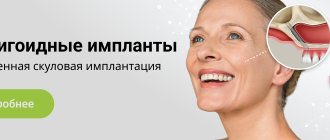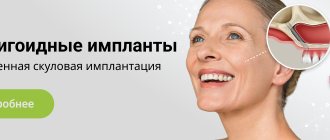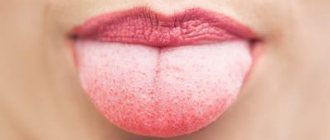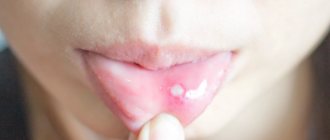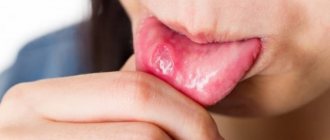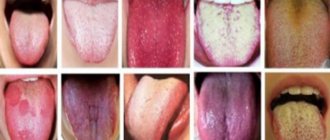7167
All parents, of course, care about the health of their children. At the slightest change in the appearance of any organs, they become very worried and try to immediately show the baby to the doctor.
However, to a lesser extent this applies to such an important part of our body as the tongue. The thing is that it is practically invisible in everyday life. And if, in addition, nothing bothers the child or he simply doesn’t think about it, then moms and dads can miss quite significant symptoms of the initial stages of some diseases.
In medical practice, the parameters of the appearance of the tongue are quite clearly defined, which are considered the norm. Its ideal condition in a healthy person, and in a child in particular, is soft, pale pink in color with clearly defined papillae
.
Plaque is also eliminated, except for light white plaque, usually in the morning, which is washed off with regular rinsing. There should be no spots of any color, especially red.
. Any such changes may indicate the onset of a disease, because the tongue is practically the calling card of the health of the whole organism.
What it is
In a healthy child, the tongue has a uniform pink color without spots or plaque. But in the presence of any pathology, spots of various colors and sizes may appear, which represent:
- An uneven accumulation of plaque on the surface of the tongue, which consists of exfoliated epithelium, tiny food particles, and microorganisms.
- Excessive proliferation of epithelium in certain areas of the mucous membranes.
- Limited inflammation.
- Benign or malignant neoplasms.
Let's look at the main reasons for the appearance of various spots and methods of treating them.
Reasons for appearance
The reasons for this phenomenon can be very diverse - from simple mechanical damage to serious illnesses. In this case, the spots can vary greatly in shade, shape, location and number
.
It is worth talking about such diseases in more detail. The list is structured in such a way that diseases are arranged in order of decreasing prevalence - from the most common to the rarer.
Stomatitis
Red spots are most likely due to one of the types of stomatitis - aphthous
. Painful ulcers (aphthae) and red spots may appear on the mucous membrane of the tongue and throughout the mouth.
If at the same time the temperature also rises, unpleasant and painful sensations and burning sensations appear in the affected areas, then these are certainly symptoms of aphthous stomatitis.
During illness, an inflammatory process begins in the oral cavity, which can be caused by multiple factors. These include decreased immunity, chemical, mechanical damage or burns due to infection, allergies, lack of nutrients, vitamin deficiency, and much more. Treatment of aphthous stomatitis in children should be prescribed by a dentist after examination.
We will tell you in detail about the treatment of mouth ulcers, giving many recipes.
This article explains why a white coating forms on a child's tongue.
Here: https://www.vash-dentist.ru/lechenie/bolezni-polosti-rta/stomatit-bpr/kak-proizvoditsya-kandidoznogo.html - talks about the treatment of candidal stomatitis in children.
Herpes
This is a very common viral disease. The herpes virus, after entering the body, remains there constantly and most of the time does not manifest itself in any way. However, during periods when the body is weakened (colds, fatigue, other diseases), the virus begins to actively function.
At the same time, red spots appear in the area of the tongue, palate, lips and cheeks, which soon turn into bubbles. They subsequently burst and leave behind red erosions.
This virus can also manifest itself as one of the types of stomatitis in children - herpetic. It is impossible to completely remove the pathogen from the body.
In fact, all treatment comes down solely to making relapses as rare as possible. The drug for local effect on the affected areas should, as in all other cases, be prescribed by a specialist.
Scarlet fever
This disease, which is classified as infectious, occurs most often in childhood. Caused by streptococcus. Carriers can be people who are carriers of streptococcus itself or have a sore throat.
During the course of the disease, red spots appear not only on the tongue, but also on the palate, throat, and tonsils. The tongue itself, under the toxic influence of the disease, becomes a very bright color - a “crimson” tongue.
It is quite easy to recognize the disease, since along with spots on the surface of the tongue, symptoms also include high fever, chills, the appearance of a rash throughout the body and a sore throat.
Glossitis
Red spots do not always appear with this disease, but often enough for it to be included in the list of the most likely causes. This is an infectious lesion of the tongue caused by various injuries or pathogenic microorganisms.
With it, an inflammatory process begins , which causes swelling, dryness and discomfort.
. Small red spots that appear as painful sores.
Dysbacteriosis
If the baby has been forced to take antibiotics or any antibacterial drugs for a long time, the entire digestive system may suffer. In this case, quite often one of the symptoms is the appearance of spots on the tongue, which have a characteristic red color and various sizes.
Geographic language
This is a dystrophic-inflammatory disease. With it, areas appear on the surface of the tongue in which the upper layer of the epithelium is exfoliated. They have a bright pink or red color and are surrounded by a white-yellow or gray rim
.
Their location is chaotic, and their shape and size are completely different. The name of the disease comes from the fact that the appearance of the tongue resembles a physical map of the world. Most often, there are no painful or intense unpleasant sensations.
There are quite a few reasons for a child’s geographic language:
- neuropathic and endocrine diseases;
- problems with the gastrointestinal tract;
- vegetative-vascular dystonia;
- diathesis;
- process of teething;
- helminthic infestations.
This may also be an individual feature of the child’s body.
Dr. Komarovsky talks about such red spots on a child’s tongue in the following video:
Hypovitaminosis
Vitamin deficiency can affect the body in completely different ways. This greatly depends on which particular vitamin (or group of vitamins) the baby lacks. In most cases it turns out to be a deficiency of vitamin B 12
.
Allergic reaction
An allergic reaction of the body to any factor can also cause redness in the form of spots in certain areas of the tongue. These reactions also include asthma.
. In this case, small redness on the surface of the tongue is quite noticeable.
The reasons for the appearance of a brown coating on a child’s tongue are discussed in our review.
This article explains how to treat oral thrush in a baby.
Here: https://www.vash-dentist.ru/lechenie/bolezni-polosti-rta/vozmozhnyie-prichinyi-plohogo-zapaha.html - the reasons for bad breath in a child are announced.
Tumors
It is quite rare for cases when poor-quality education in the field of language begins to develop. One of its first symptoms is the appearance of red spots on the surface.
Kawasaki syndrome
Refers to autoimmune diseases. The causes of the occurrence have not been described, although some experts talk about a virus or other similar pathogen.
The course of the disease begins with a strong increase in temperature, then a rash appears throughout the body, including on the tongue and mucous membranes
. This disease is most dangerous due to weakening and damage to the coronary arteries and complications in the heart.
White
In a baby, the appearance of white spots on the tongue most often indicates thrush - a fungal infection of the mucous membranes due to a decrease in immune defense in the body or when taking antibiotics. Such spots are located asymmetrically, can have a variety of sizes, and are often covered with a cheesy coating.
If a child shows signs of thrush on his tongue, then it is necessary to visit a pediatrician who will find out the reasons for its appearance. Delay in treatment can cause progression of the disease and inflammation of the mucous membrane, which will cause pain and discomfort in the child. You cannot try to remove the plaque on your own; this can lead to additional trauma. To eliminate such white spots, it is most often recommended to treat the child’s oral cavity with a weak solution of baking soda or ordinary brilliant green. In more severe cases and with relapse of the disease, it may be necessary to take antifungal drugs.
Treatment
It is not recommended to carry out treatment on your own in any case. Before taking your child to the doctor, it is very important not to give him any medications or alleviate the symptoms, as this may complicate the diagnosis.
If parents do not know which specialist to contact, then they should go to their general practitioner or pediatrician. After the examination, he will refer you to the right doctor - an ENT specialist or a dentist, depending on the symptoms.
Treatment almost always consists of eliminating the cause - the disease that caused such symptoms
. In most cases, local therapy is also used - relieving pain and discomfort with the help of anesthetic ointments or gels, antibacterial and other rinses.
Due to the fact that the causes of red spots on the surface of the tongue are very diverse, each case requires different research methods and, accordingly, treatment.
If you find an error, please select a piece of text and press Ctrl+Enter.
Tags in children's tongue
Did you like the article? stay tuned
Previous article
Mexidol Dent toothpaste: description, types and prices
Next article
Basal implants: description, review of different manufacturers, prices
Geographical
If red spots and a white coating along their edges appear on the tongue, then this is a sign of a geographic tongue - desquamative glossitis. The disease is not inflammatory in nature and may indicate some hormonal disorders, worms and problems in the digestive system. Such spots do not have smooth outlines, they quickly change their location and do not bother the child in any way. They can be oval, round or have fancy shapes.
This disease lasts a long time and often goes away on its own after some time, even without specific therapy. Sometimes antiseptics, vitamins and drugs that accelerate tissue regeneration processes are used to treat geographic tongue. But most experts (for example, Dr. Komarovsky) believe that there is no need to treat geographic spots.
Types of plaque and reasons for its appearance
To understand why the tongue becomes spotted, you need to take a closer look at the plaque covering it. Usually it precedes spots that form as a result of a violation of its structure or after the plaque “peels off.” The film on the tongue of an infant or older child can be of the following shades:
ThrushThin white coating . Often observed in newborns and children in the first year of life. Appears in the morning, structurally it is a thin, transparent film of whitish color. It is enough to remove the deposits with a damp gauze swab so that they no longer appear during the day. This plaque is an allergic reaction of the baby to an artificial formula or to products that make up the mother’s diet (during breastfeeding).
- Curdled white coating. A dense film of rich white color with hidden ulcers, foul-smelling and difficult to remove - a symptom of thrush (candidiasis) or stomatitis. In infants with such diseases, instead of a solid plaque, white spots of very impressive size often form.
- Yellow plaque . Formed when there is a malfunction of the child’s liver, kidneys or bile ducts.
- Fungal infection of the tongue
Gray plaque . The initial sign of dangerous childhood diseases - scarlet fever and diphtheria. Sometimes this appearance of the taste organ indicates severe dehydration. In both cases, you need to start treating the root cause of the symptom as soon as possible, since such diseases are dangerous not only for the health, but also for the life of the baby.
- Plaque in the form of green spots . The manifestation indicates a fungal infection in the oral cavity of a small patient. Usually the rash spreads to the palate, cheeks, and mucous membranes of the lips.
- Brown deposits . The result of a malfunction of the digestive system, accompanied by stagnation of bile in the bile ducts. In infants, the symptom often signals dehydration; in older children, it indicates a deficiency or malabsorption of B vitamins. In addition, if brown spots appear on the baby’s tongue, an allergy to herbs can be suspected, even if the nursing mother takes them.
- Black deposits . They are a consequence of taking certain antibiotics, overdose or the body’s rejection of the drug. Sometimes the reasons for the appearance of black plaque lie in intestinal disorders: colitis, enteritis and gastritis.
Reds
The appearance of red spots on a child’s tongue is a sure sign of an infectious or inflammatory process in the oral cavity:
- stomatitis;
- glossitis;
- bacterial dermatosis;
- herpetic infection.
Also, red spots may be due to an allergic reaction or consumption of foods that are bright red in color.
Very often, such formations are accompanied by unpleasant symptoms: pain in the tongue, a feeling of discomfort, increased salivation. Due to pain, children may be capricious and refuse to eat or drink. The general condition may also suffer - body temperature rises.
Only a doctor should treat red spots. After establishing an accurate diagnosis, the following may be prescribed:
- treatment of lesions with antiseptic agents;
- taking antibiotics or antivirals;
- use of anti-inflammatory medications.
We relieve inflammation of the tongue and get rid of red spots
Miramistin is used against everything! But now it's expensive.
If the doctor has not identified any serious illness, then irritation on the tongue can be removed with the help of anti-inflammatory solutions, which are freely sold at pharmacy kiosks. The following tools have proven themselves to be effective:
- " Chlorophyllipt ". The oil solution is light green in color. The base contains eucalyptus extract. Apply to the tongue using a cotton swab. Can be used up to 5 times a day . The downside of the drug is its unpleasant taste. Can be used for children over 12 years old .
- " Holisal ". Has an antibacterial effect. Ideal for stomatitis, allergies, herpes. The product must be rubbed into the tongue. Allowed for children from 1 year. The drug relieves swelling well, relieves itching and pain.
- " Inhalipt ". Available in spray form. Mainly used for sore throats. But often doctors recommend spraying the tongue with the product. Mint and eucalyptus included in the composition relieve swelling, pain, and discomfort. Can be used by children from 5 years of age . And for babies from birth it is worth using the analogue “Inhalipt N”.
- " Blue ". Specific remedy. Used to heal wounds and ulcers in the mouth. Has a bright blue color. Apply at night.
- " Miramistin ". An excellent product that quickly combats pathogenic microorganisms. Available in spray form. Can be used on mucous membranes. It is quite gentle and pleasant to the taste. The downside is the high pricing policy of the drug .
Advice! These drugs are considered harmless, but if a child has a serious illness (stomatitis, herpes, scarlet fever), the cause of the disease must be removed, antibiotics and antivirals must be used.
Traditional methods
This is exactly how our mothers treated us!
It is impossible not to touch upon the topic of folk methods of getting rid of red spots on the tongue. The most popular and effective are the following:
- Decoction of medicinal chamomile . The decoction is brewed according to the instructions indicated on the herb packaging. You can rinse your mouth every hour. Chamomile has an anti-inflammatory, antiseptic effect, dries well and relieves pain.
- Sage tincture . Pour 15 g of herb into a glass of boiling water, let it cool and rinse your mouth.
- Aloe juice . The plant juice must be diluted with water (proportion 1:10). Treat each spot with the resulting solution.
It is important! You cannot use salt, soda, or iodine. These remedies will only intensify the inflammatory process and cause burning and itching. But it's also worth thinking about the menu. Exclude spicy, sour, hard foods from the composition and nutritional standards. It is better if these are liquid dishes.
Dark
Dark spots on the tongue often occur when eating food that contains dark pigments that color the plaque on the surface of the mucous membranes. Such spots do not pose any danger to the child and disappear after hygiene procedures. But there are a number of conditions that manifest as dark spots in the mouth and which can have very serious consequences.
Black
Black spots on the tongue in children most often appear during a long course of antibiotic therapy as a result of the active proliferation of microorganisms and fungi. Blackening of the tongue develops gradually and can last up to 2-3 weeks. The main treatment for this condition is to restore normal microflora in the child’s intestines and oral cavity. For this purpose, eubiotic drugs are prescribed (for example, Linex, Bifidumbacterin, Lactobacterin).
It is extremely rare that black spots on the tongue appear as a result of deep degenerative processes accompanied by necrosis of areas of the mucous membrane. This condition is very dangerous and requires emergency medical attention. The treatment of such spots is often surgical.
Blue
Blue spots in a child's mouth are a rare occurrence. They may appear in the following situations:
- The presence of severe heart failure due to heart disease and defects. Spots on the tongue appear due to stagnation of blood in the venous bed and are accompanied by blue discoloration of the lips and limbs. Their treatment consists of eliminating cardiac pathology and normalizing blood microcirculation in the vessels.
- With the growth of a benign vascular tumor - hemangiomas. This blue spot is most often single. Treatment is only possible through surgery.
How to treat spots on the tongue?
Treatment of any changes in a child’s oral cavity should be based on eliminating the cause of the problem. Approaches to the treatment of spots on the tongue are varied, since not only dental diseases can cause them.
Most often, the child and parents are faced with stomatitis or a fungal infection of the oral cavity. Principles for treating this problem:
- careful adherence to oral hygiene;
- taking antibacterial or antiseptic drugs, most often local in the form of sprays and rinses;
- taking local antifungal agents (in case of candidiasis, but not for prevention);
- taking local immune activators.
In the case of spots on the tongue as a manifestation of an allergic reaction, you first need to determine what caused it and stop contact with the irritating substance. Additionally, antihistamines are used. In some cases, allergy symptoms appear due to incorrect, too rapid introduction of complementary foods to infants4.
If spots form due to a herpes infection, antiviral agents should be used, most often acyclovir drugs. Treatment of blisters and sores should be carried out using hydrogen peroxide, and then lubricated with an oil solution based on eucalyptus. Vitamin complexes and immune medications will help speed up recovery.
Spots that arise as a result of disturbances in the gastrointestinal tract disappear after exposure to the cause of the problem. Depending on the disease, the child may be prescribed medications that improve gallbladder function, normalize acidity in the stomach, probiotics and live beneficial bacteria to improve intestinal function.
Bald
Normally, the lingual surface is covered with a large number of small taste buds, which give it a velvety appearance. If such papillae die or atrophy for any reason, “bald” spots appear. They are pink in color, irregular in shape and do not spread to the mucous membranes of the cheeks, lips or gums.
Reasons that can cause the appearance of such pink “bald” spots:
- Inflammatory diseases (glossitis, stomatitis).
- Tongue injuries.
- Burns from heat or chemicals.
“Bald” spots do not cause any inconvenience to children, but may slightly change the taste sensations. It is impossible to cure such formations, since the taste buds cannot be restored.
If you find that your one-year-old or older child’s tongue has become spotted, you should not panic and try to treat it yourself. Also, the appearance of spots on the tongue should not be ignored, as they may indicate the presence of serious diseases. It is necessary to consult a doctor who will find out the exact cause of such changes and, if necessary, select appropriate treatment for the child.
Signal for parents
Photo: small red spots on a child’s tongue
First of all, it is worth advising parents to examine their baby’s tongue more often. Especially if he is still too young - preschool age. The very first thing they should do when they discover a red spot during examination is to inquire about the well-being of their son or daughter and immediately consult a doctor
.
Manifestations such as red spots on the tongue can signal a huge number of diseases, which only a specialist can diagnose after a thorough examination and interview of a small patient, as well as a series of tests.
However, you should not immediately fall into a state of despair and panic. After all, most of these diseases, although unpleasant, are quite easily treated with modern means and do not pose a serious threat to life.
The location of such formations may also be important. Each part of this organ is associated with one of the parts of the body. Therefore, you also need to pay attention to the location of the changed areas.
Here is a short list of “related” bodies:
- the liver and gall bladder are associated with changes in the lateral parts;
- intestines - with the root part;
- the rear area between the horse and the center - with the kidneys;
- the central region - with the spleen;
- the front part (third) - with the lungs;
- tip - with a heart.
As you can see from this list, most cases of red spots on the tongue indicate some kind of problem with the gastrointestinal tract.
However, there is no need to draw hasty conclusions and take the baby to a nephrologist or cardiologist. It is not at all necessary that such manifestations will be a sign of serious disorders or illness.
The reasons that cause red spots to appear on the surface of the tongue in children will be discussed in more detail. At the same time, you need to know that the larger and brighter the changes that have occurred, the more serious the problem they can be caused.
